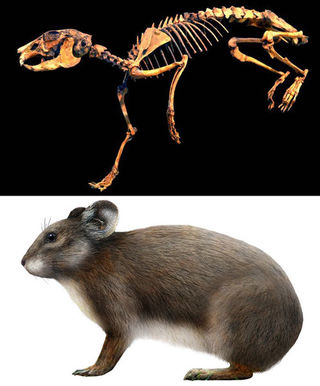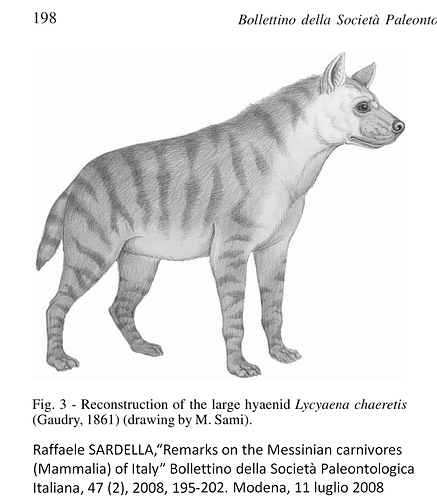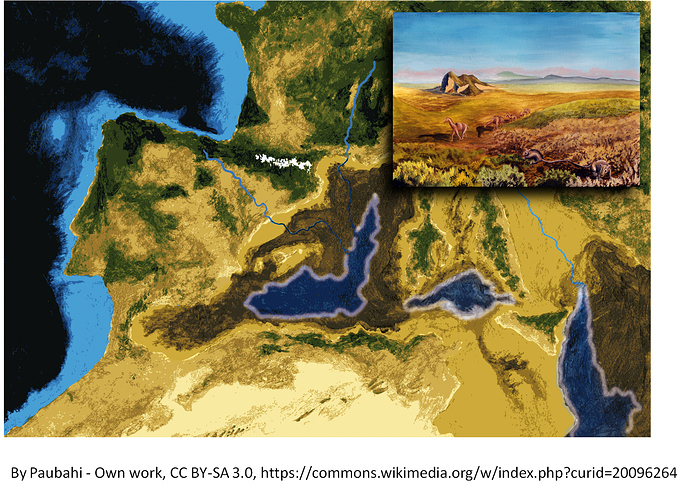There are two layers, Bill, The final desciccation took place and no more salt was deposited. It was at that time that the salt was covered with sediment so that when the flood happened, the salt didn’t dissolve.
In what follows, I encourage you to read to the end. there is an amazing fossil there that I don’t fully know what to think about, but it fits my view.
I spent my chemo time tooling around in the paleontological literature for the Messinian in the Mediterranean. I found three articles rather quickly which outlined a large fauna living on the floor of the desiccated Mediterranean. This areas have since been lifted above sea level by the slow movement of Africa into Europe. This article:
Simone Colombero, Chiara Angelone, Edmondo Bonelli, Giorgio Carnevale, Oreste Cavallo, Massimo Delfino, Piero Giuntelli, Paul Mazza, Giulio Pavia, Marco Pavia, and Giovanni Repetto, The upper Messinian assemblages of fossil vertebrate remains of Verduno (NW Italy): Another brick for a latest Miocene bridge across the Mediterranean” N. Jb. Geol. Paläont. Abh. 272/3 (2014), 287–324 Article Stuttgart, June 2014
examined the Verduno section of Italy. While they used species, genus etc for animal identification, I spent some time translating them into normal animal names. They found
African primates.
Hyaenictitherium (also of African affinity)
toads
frog two types
Turtles
Lizards, 2 types
Monitor lizars, iguana type lizards, worm lizards
thread snakes and colubrine snakes
legless Amphisbaemia called worm lizards
Pheasant like birds (Galliforme
Accipitridae birds (birds with strongly hooked bills
Owls,
Gomphotheriidae–ancient elephant
small giraffes
Huge giraffes
small antelope (bovidae)
Gazelle
possible camel
Eucyon monticiensis: similar in size to a Jackal
lynx-like cat
Sabre tooth cat
rabbit or pika
5 species or mouse
2 species of dormouse
Here are a couple of pictures of two of the animals found in Italy

The western Med at that time looked like this:
At another Italian outcrop they found civet like or gennet like animals.
:
“They pointed out strong affinities between the Baccinello V3 fossil, Viverra n. sp. “A” from Sahabi, Libya (Howell, 1987) and Viverrinae sp. indet from Lothagam, Kenya (Werdelin, 2003), thus erecting the species Viverra howelli. This species is characterized by a relatively small size and a lower carnassial with a short talonid. ” Raffaele SARDELLA,“Remarks on the Messinian carnivores (Mammalia) of Italy” Bollettino della Società Paleontologica Italiana, 47 (2), 2008, 195-202. Modena, 11 luglio 2008, p. 196
http://paleoitalia.org/media/u/archives/195_Sardella.pdf
**
“ The following hyaenid taxa have been collected from Italian Messinian localities: Plioviverrops faventinus Torre, 1989 (Brisighella; Fig. 2), Plioviverrops orbignyi (=Ictitherium orbignyi) (Gaudry & Lartet, 1856) (Gravitelli), Hyaenictitherium hyaenoides (Zdansky, 1924) (=Ictitherium hipparionum) (Gravitelli), Hyaenictitherium sp. (Verduno), Lycyaena chaeretis (Gaudry, 1861) (=Thalassyctis (Lycyaena) ex gr. chaeretis-macrostoma) (Brisighella), Hyaenidae indet. (coprolites) from Baccinello V3.” Raffaele SARDELLA,“Remarks on the Messinian carnivores (Mammalia) of Italy” Bollettino della Società Paleontologica Italiana, 47 (2), 2008, 195-202. Modena, 11 luglio 2008, p. 197
**
Mustellidae “ The Mustelidae are a family of carnivorous mammals, including weasels, badgers, otters, ferrets, martens, minks, and wolverines, among others. ”
“At Brisighella Rook et al. (1991) referred a mandibular branch with teeth to Mellivora beinfieldi,” Raffaele SARDELLA,“Remarks on the Messinian carnivores (Mammalia) of Italy” Bollettino della Società Paleontologica Italiana, 47 (2), 2008, 195-202. Modena, 11 luglio 2008, p. 199
**
“Sabertoothed cats have been recorded in the Baccinello V3 horizon faunas (Rook et al., 1991) and Gravitelli (Seguenza, 1902, 1907). The occurrence of Metailurus major in the late Messinian of Italy is testified by two mandibles with teeth having the typical size and morphological characters of this species, widespread in the Eurasian Late Miocene deposits.” Raffaele SARDELLA,“Remarks on the Messinian carnivores (Mammalia) of Italy” Bollettino della Società Paleontologica Italiana, 47 (2), 2008, 195-202. Modena, 11 luglio 2008, p. 199
In the eastern Med, Greek strata of Messinian age show these species living on that dry land M10 is the top of the Messinian. I will let yall look up the species or genus to see what the common name is, but there are lots of creatures listed.
Kastellios , 1 , 2 , 3
MN 10
(Steininger et al. 1 9 9 6 ) Cricetulodon c f . sabadellensis, Dorcatherim s p ., Hipparion s p., Muscardinus s p ., P rogonomys woelferi, P. cathalai, Spermophilinus c f . b re d a i (De Bruijn & Zachariasse 1979).
Ravinde la Pluie
MN10
(Steininger et al. 1996) A d c rocuta eximia, Bohlinia attica, C h o e rolophodon pentelicus, Cremohipparion macedonicum, Decennatherium macedoniae, Graecopithecus fre y b e rgi, Hippotherium pri migenium, Mesembriacerus melentisi, Palaeotragus coelophrys, P.roueni, Plioviverrops orbignyi, Progonomys catalai, P rostrepsiceros vallesiensis, Protictitherium gaillardi, Samotragus praecursor ( Koufos1989, De Bonis et al. 1988, NOW 1 9 9 5 , Bernor et al. 1996a) .
Ravin de Zouaves 1
MN10 (NOW1995)
Adcrocuta eximia, Choerolophodon pentelicus, Cremohipparion macedonicum, Helladotherium duvernoyi, Ictitherium s p ., Mesembriacerus melentisi, Ouzocerus graci lis, Samotragus praecursor (Koufos 1989, Bernor et al. 1996a )
And I have said that the eastern end of the Med was Eden. I have also said that God has dealt with us for a long long time, at least 5.5 my years. I don’t believe that the image of God must be in H. sapiens only. I do beleive that God implanted the image to Adam and Even who were small brained hominids. I also believe that the curse on both Adam and Eve are effects of an enlarged head. that means Adam and Eve DIDN’T have enlarged brains. They were small brained hominids.
Because of the above, I would point out that there is a controversial report, of human footprints on Crete in the Messinian strata. The idea is controversial because it challenges current ideas. Even the authors don’t know what to think of this anomaly. I don’t know what to think of this anaomaly, but it does fit my scenario, not the normal scenario.
Title: Possible Hominin Footprints from the Late Miocene c. 5.7 Ma) of Crete?" Possible hominin footprints from the late Miocene (c. 5.7 Ma) of Crete? - ScienceDirect

